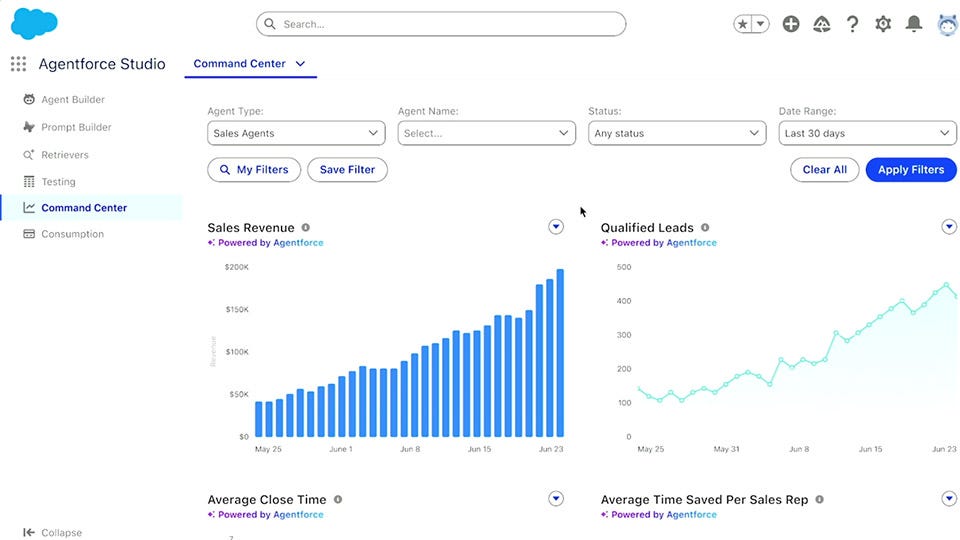Salesforce Wants to Scale Digital Labor. Agentforce 3 Is the Plan.
Salesforce’s latest update introduces a Command Center, open integration standards, and enhanced AI architecture to help enterprises manage and expand AI agents
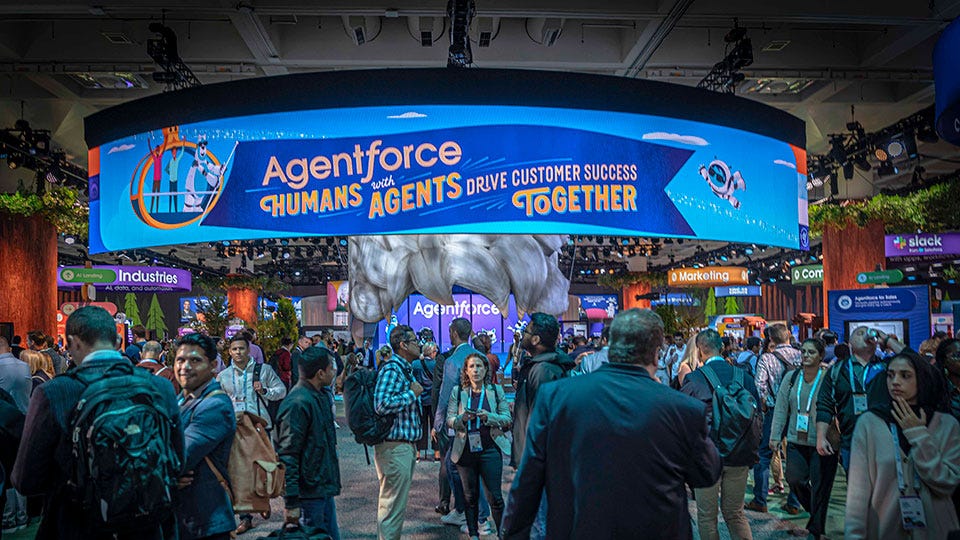
Salesforce is scaling up its agentic development platform, adding features to help organizations embrace the hybrid workforce paradigm. Agentforce 3 is the latest in a series of rapid-fire innovations from the enterprise tech giant. This release introduces a new Command Center for overseeing AI agents, adds support for the Model Context Protocol (MCP) across Agentforce and within newly available tools in AgentExchange, and brings key upgrades through the enhanced Atlas architecture.
Chief executive Marc Benioff once described AI as being a “transformational moment,” proclaiming this “third wave of AI,” in which we’re in now, will be defined by agents. Since launching Agentforce in October 2024, Salesforce hasn’t been gun-shy about its ambitions in this space. The company quickly followed up two months later with Agentforce 2.0, which saw AI agents in Slack and advanced Atlas reasoning. And then in March, the platform started enabling agents to become “proactive,” signaling the rise of the digital labor force.

To help accelerate this adoption, Agentforce 3 features new tooling that provides teams with clearer insights into agent performance while expanding what bots can do through plug-and-play-like third-party integrations.
“With Agentforce, we’ve unified agents, data, apps, and metadata to create the digital labor platform,” Adam Evans, Salesforce’s executive vice president and general manager of Salesforce AI, says in a statement. “Over the past several months, we’ve listened deeply to our customers and continued our rapid pace of technology innovation. The result is Agentforce 3, a major leap forward for our platform that brings greater intelligence, higher performance, and more trust and accountability to every Agentforce deployment. Agentforce 3 will redefine how humans and AI agents work together—driving breakthrough levels of productivity, efficiency, and business transformation.”
A Central Command Center for Agents
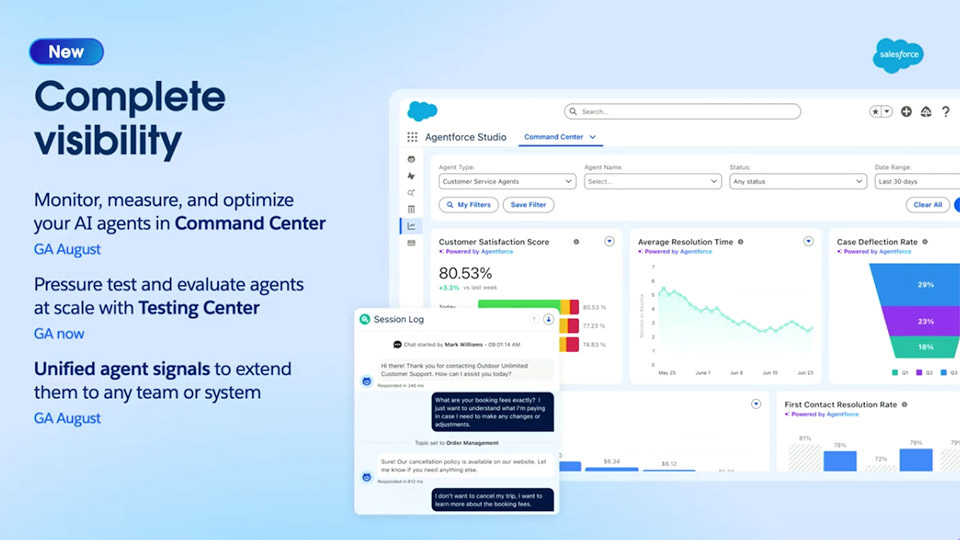
Salesforce is not alone in identifying this digital labor trend—its chief rival, Microsoft, has published research that suggests so-called “Frontier Firms” are the new goal for digital transformation. However, organizations shouldn’t expect the next-generation workforce to consist of one or two agents. Instead, they should expect a one-to-many setup, with one human overseeing multiple bots assigned to specific tasks.
Recognizing that employees will be juggling multiple agents, Salesforce has developed the Agentforce Command Center, a dashboard that enables human workers to monitor, measure, and optimize AI agents. The company refers to this as the “observability layer,” providing humans with a comprehensive view of an agent’s health, measuring performance, and optimizing outcomes. The command center is a part of Agentforce Studio, its agent customization hub, where businesses can build, manage, and tailor their digital workforce.
"Customers keep asking us, 'How do I measure, manage, and optimize my AI agents?' and it doesn't matter if you're a CIO, head of service, sales, or marketing—everybody wants to know how agents are performing against their most important and strategic KPIs," Sanjna Parulekar, Salesforce's senior vice president of product marketing for Agentforce, explains during the company's release event.
What can the Agentforce Command Center do? Salesforce claims the service enables teams to analyze every AI agent interaction, drill into specific conversations, understand usage trends, and receive AI-powered recommendations on how to improve Agentforce development. Moreover, it provides detailed adoption analytics (e.g., success rates, deflections, feedback, and cost).
This universal dashboard, or what Parulekar calls a “unified pane of glass,” gives teams a central vantage point to understand how agents are serving their organizations. Without it, human workers are likely left to analyze bots individually, adding more work to their plates and eliminating the point of why agents are being used in the first place.
It's "where you can monitor agent health, measure performance, and optimize the impact of your agents in real-time. And it's built right into Agentforce Studio, so it's available for every builder and every single team. We also give you visibility into the entire agent lifecycle, so you can test every agent at scale before deployment, drill into every agent interaction to uncover insights about individual conversations. You can track adoption, deflection, and cost in custom dashboards. You can even get real-time alerts on latency errors and so much more."
When asked how Command Center will impact how organizations view AI agents, Parulekar proclaims, "Simply put, this is how agents go mainstream."
While new to Agentforce, Salesforce’s Command Center reflects a broader enterprise trend: giving teams clearer visibility into how AI is performing. If teams can’t see what AI is doing or whether it’s actually helping, they’re unlikely to use it. Salesforce now joins peers like ServiceNow in introducing tools designed to solve that problem.
Command Center will be generally available in August.
Agentforce Supports MCP and A2A
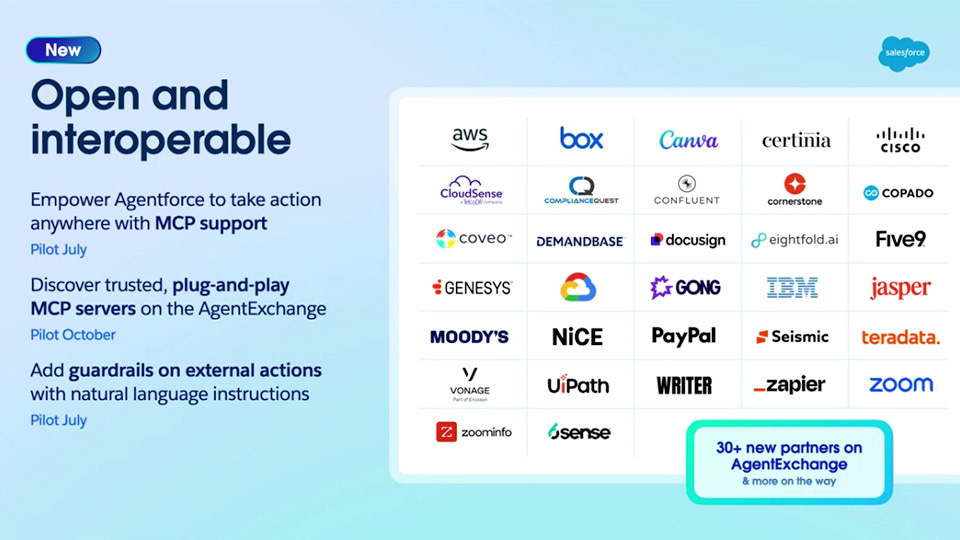
Salesforce is also leaning into interoperability with built-in support for MCP and Google’s Agent2Agent (A2A) standard. The former, an ever-increasingly popular open standard, enables agents to connect easily to external tools and services without requiring custom integration work. The latter, introduced in April, functions as a similar interoperability protocol, for which Salesforce was one of the first partners to back.
The company asserts that Agentforce 3 offers the enterprise tool connectivity organizations want, along with the security and trust layer they need. The addition of this “USB-C for AI” feature means that Agentforce-created bots can integrate seamlessly with third-party enterprise systems.
The MCP work also extends to other apps within the Salesforce ecosystem. Teams can transform existing APIs into MCP-compliant services in MuleSoft. They can also host custom MCP servers using Heroku. Lastly, Slack is offering a native MCP server with Anthropic, permitting external agents to be grounded on Slack’s message and file history, deliver contextual insights, and take action within the productivity app. This comes weeks after Salesforce modified Slack’s Terms of Service, prohibiting third-party developers from indexing, copying, or permanently storing Slack messages through its API.
"MCP...is all the rage," Evans states. "This is kind of the continued acceleration we're seeing across the board with AI impacting everything. In this case, it's about how to connect systems and then [about] interoperability. What's really important...is the idea isn't now hard to actually create the connectivity. It's how to make sure that you're using it correctly and governing it and being able to put in the instructions and guardrails."
As for A2A, the company was not as forthcoming with details on how Agentforce will support Google's interoperability standard. That said, Gary Lerhaupt, Salesforce's vice president of product architecture for Agentforce, points out, "It's the same sort of pattern where you think about discovery and governance. You're going to think about AgentExchange as being that place where we're going to provide those sorts of multi-agent, certified agents that we want to bring into Agentforce. And then, again, governance, you're going to be able to install that in and say, 'I want to make this agent available to these particular personas, these particular use cases.' And then, the builders are going to be able to connect that in and orchestrate that to do all sorts of new types of dynamic multi-agent experiences. It's a super exciting roadmap in front of us."
The embrace of MCP and A2A appears aimed at positioning Agentforce as the connective tissue for enterprise AI, both within Salesforce’s ecosystem and beyond it. While the company may not own every workflow outside of sales and marketing, it’s betting that AI agents can still drive value in adjacent tasks by integrating with third-party tools and systems.
Still, Salesforce isn’t the only one moving in this direction—companies like HubSpot, Cloudflare, Atlassian, Block, Notion, and Zapier have launched MCP servers, signaling broader momentum around these interoperability standards.
AgentExchange Expansion
Now that Salesforce has added tools to monitor AI agents and enabled them to connect with a broader range of systems, the company is also expanding its marketplace of agent-ready components. Launched in March, AgentExchange offers customers access to a pre-built library of agents and partner actions, topics, prompts, and agent templates. Today, the company is introducing new MCP tools from more than 30 companies that have been tested and approved by Salesforce to work with Agentforce.
For example, through Box, one of Salesforce’s first MCP launch partners, AI agents can fetch signed NDAs, summarize key terms, and post updates directly to Slack. Additionally, with PayPal, teams can use Agentforce to generate invoices and process transactions automatically through its MCP-enabled commerce tools. Lastly, WRITER’s MCP integration allows agents to generate content, surface relevant knowledge, and run compliance checks.
These MCP-enabled tools won't start to be available on AgentExchange until October under a pilot program.
Updated Atlas Engine
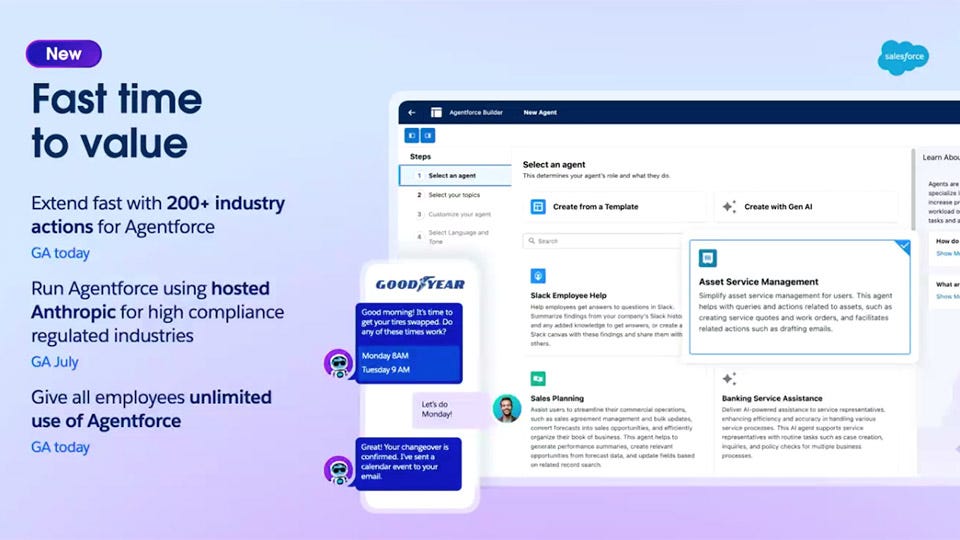
The final update to Agentforce 3 involves upgrading its Atlas Reasoning Engine. This in-house-built technology is designed to “simulate how humans think and plan,” evaluating user prompts and refining them for clarity and relevance before surfacing the most relevant data. It was last updated in December 2024. However, now, Salesforce has improved it with lower latency, greater accuracy, additional model choices, and made it more worldly.
According to the company, Agentforce has become more responsive thanks to its work lowering latency by 50 percent over the past six months. It didn’t reveal how it accomplished this feat, but it states that the platform is more responsive. Moreover, Salesforce is announcing that streaming is now generally available, meaning users can see responses as they’re being generated.
The improved Atlas also leverages Web search as a data source, helping to ground Agentforce responses. Inline citations are now being added to agent answers that provide references to the grounding sources used.
Since its introduction, Atlas has been powered by OpenAI, along with Salesforce’s own data. Today, the company says it's getting into the hosted model game, starting with Anthropic's Claude—it'll be generally available in July. Salesforce hasn’t disclosed which specific Claude variants are available, but they’ll be accessible through Salesforce Infrastructure via Amazon Bedrock and are targeted towards customers in regulated industries. "This is a really big deal," Susannah Plaisted, Salesforce's director of product marketing for Agentforce, declares. "Those trade-offs you had to make between agent security and accuracy, they no longer have to slow you down, because you can choose to have your agents reason using Salesforce-hosted Anthropic, which means your data stays completely within the Salesforce boundary—an absolute game-changer for our customers in regulated industries."
Salesforce isn't the first company to adopt the self-hosted model, and it makes sense for companies in regulated industries. In May, Microsoft announced it is bringing first-party models to its Azure Foundry, starting with xAI's Grok 3.
And Claude is only the start—Salesforce discloses Google’s Gemini is coming later this year.
For those Salesforce customers outside the United States eager to try out Agentforce, the platform is being deployed in five new countries: Canada, the United Kingdom, India, Japan, and Brazil. It also supports six new languages—French, Italian, German, Spanish, Japanese, and Portuguese—with plans to add 30 more in the coming months.
Staying One Step Ahead in the AI Race
Salesforce is practically betting the farm on the digital labor movement. To help it achieve its goals, the company has been on an aggressive acquisition spree lately, not dissimilar to what Meta is doing. Among its most recent acquisitions are Informatica, the AI automation startup Convergence.io, and Moonhub. However, while those in Big Tech are pursuing either Artificial General Intelligence or Superintelligence, Salesforce appears focused on strengthening its organization and platform to facilitate a world where humans and virtual bots collaborate in the workforce.
Since launching Agentforce, Salesforce has seen a wave of competitors enter the market with their approaches to agent development. All are eager to seize on complaints from dissatisfied Salesforce customers. Agentforce 3 is its answer to that growing pressure, but will it be enough to turn the tide? Along with the addition of more observability and interoperability, this next-generation version is the first to feature Salesforce’s new simplified and flexible pricing structure. More specifically, Agentforce for Sales, Service, and Industry Cloud has adopted per-user pricing, which allows for unlimited agent actions under each license.
"All of this is really about bringing agents closer into and across the business use cases, in a hybrid workforce," Evans declares.



